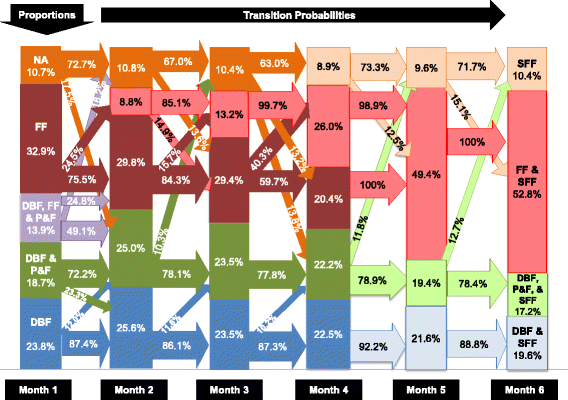Infant feeding pattern in the first six months of age in USA: a follow-up study
- PMID: 29213297
- PMCID: PMC5712088
- DOI: 10.1186/s13006-017-0139-4
Infant feeding pattern in the first six months of age in USA: a follow-up study
Abstract
Background: Infant feeding may consist of direct breastfeeding (DBF), pumping and bottle feeding (P&F), formula feeding (FF), solid food feeding (SFF), and any combination. An accurate evaluation of infant feeding requires descriptions of different patterns, consistency, and transition over time.
Methods: In United States of America, the Infant Feeding Practice Study II collected information on the mode of feeding on nine occasions in 12 months. We focused on the first 6 months with six feeding occasions. To determine the longitudinal patterns of feeding the latent class transition analyses was applied and assessed the transition probabilities between these classes over time.
Results: Over 6 months, 1899 mothers provided feeding information. In month 1 the largest latent class is FF (32.9%) followed by DBF (23.8%). In month 2, a substantial proportion of the FF class included SFF; which increases over time. A not allocated class, due to missing information was identified in months 1-3, transitions to SFF starting in month 4 (8.9%). In month 1, two mixed patterns exist: DBF and P&F combined with FF (13.9%) and DBF combined with P&F (18.7%). The triple combination of DBF, P&F, and FF (13.9%) became FF in month 2 (transition probability: 24.8%), and DBF in combination with P&F (transition probability: 49.1%). The pattern of DBF combined with P&F is relatively stable until month 4, when at least 50% of these infants receive solid food. Only 23-26% of the infants receive direct breastfeeding (DBF) in months 1-4, in month 5-6 SFF is added. Mothers who used FF were less educated and employed fulltime. Mothers who smoke and not residing in the west of the United States were also more likely to practice formula feeding.
Conclusion: Infant feeding is complex. Breastfeeding is not predominant and we additionally considered the mixed patterns of feeding. To facilitate direct breastfeeding, a substantial increase in the duration of maternal leave is necessary in the United States.
Keywords: Breastfeeding; Formula feeding; Infant feeding; Pumping and feeding; Solid food feeding; United States of America.
Conflict of interest statement
Ethics approval and consent to participate
Ethical approval was conceived by the Food and Drug Administration (FDA) and the Centers of Disease Control (CDC) before conducting the survey. The secondary data analysis was approved by the University of Memphis (IRB Determination Protocol #4099).
Consent for publication
Not applicable.
Competing interests
The authors declare that they have no competing interests.
Publisher’s Note
Springer Nature remains neutral with regard to jurisdictional claims in published maps and institutional affiliations.
Figures

References
-
- Maria-Mengel MR, Martins Linhares MB: Risk factors for infant developmental problems. Rev Lat Am Enfermagem 2007, 15 Spec No:837-842. - PubMed
LinkOut - more resources
Full Text Sources
Other Literature Sources

